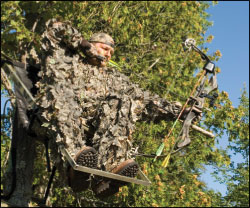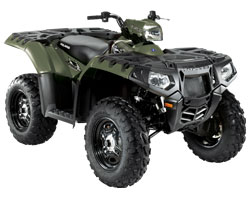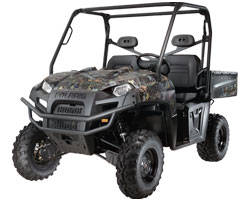Kick-Starting Your Management Plan
Last month we talked about mapping and planning habitat improvements and hunting setups. Now it’s time to roll up your sleeves and go to work. Naturally, with its rugged construction, passenger capacity and box capable of holding all your gear and tools, your Polaris® RANGER 800 XP® is the perfect vehicle for QDM work.

Your mapping plans designated at least one deer sanctuary on your property. But a simple “hands-off” policy isn’t enough. Make this zone attractive to deer—especially mature bucks—by creating the thick cover whitetails love. Visit your sanctuary with a chainsaw and begin felling or hinge-cutting any trees that have little or no timber value. Species such as box elder, aspen, sweet gum and maple are perfect candidates. While a small clearcut will look ugly at first, young brush and sun-loving saplings will quickly sprout in the openings you create…and deer will flock to this nutritious browse and dense security cover.
The next mission is to begin food plot construction and planting. Unless you have access to a tractor, it may be necessary to hire someone to till and plant larger destination-type food plots. But your property blueprint includes several smaller hunting plots, and the perfect tool for creating and maintaining these areas is a Polaris RANGER 800 XP. This new RANGER has an 800 Twin EFI engine and Dual A-Arm Front suspension, a feature that makes for easier steering, no harsh feedback over humps and superior ground clearance. Even better, the RANGER 800 XP’s exclusive True All-Wheel Drive reacts automatically to terrain changes. This way you can easily handle the XP to clear, till and plant food plots. You’ll have the satisfaction of creating a food source—and hunting area—that will exist for many seasons. Finally, don’t forget to include a mineral lick near some of your plots; they’re not only attractive and beneficial to deer, they provide an excellent place to mount a trail camera!
If you’re new to food plotting, deciding what to plant can be confusing. Start by buying seed from a reputable company and consult with them about what grows best in your area. Their advice on preparing your plots, successful seed varieties and planting timetables can save a lot of time and money. Generally, it’s best to divide even smaller plots in half, planting each section to a plant type that will mature at different times to offer deer another choice when they visit your salad bar!
Finally, it’s never too late—or too early—to begin work on stand sites. Here again, your RANGER is the perfect tool for hauling stands, ladders, steps, saws and other tools you’ll need to set up the perfect stand site. And don’t forget your chainsaw! Dropping some trees to steer deer into a food plot (or through a funnel) exactly where wind direction and cover favor you is a good hunting tactic. For example, deer will have several entry trails into one of your hunting plots, and some of them may be downwind of your stand. Dropping one or more trees across these paths forces whitetails to loop around them and enter the plot upwind—and in range—of your site. You’ve taken a good spot and made it a great one!
ADVERTISEMENT
Related Vehicles
The Polaris Sportsman® 850 XP
Sportsman XP Facts:
- 850 SOHC Twin EFI Engine
- Available Electronic Power Steering
- Legendary Smooth Rolled Independent Rear Suspension (IRS)
- Superior Ergonomics
Learn More about the Sportsman XP >>
The Polaris RANGER 800 XP®
Ranger 800 XP Facts:
- New! 800 Twin EFI Engine
- Available Electric Power Steering
- Dual A-Arm Front Suspension
- Legendary Smooth Independent Rear Suspension (IRS)
Deer Management Archive
2009 Archive
- How to Judge a Trophy Buck's Potential
- Kick-Starting Your Management Plan
- Mapping Your Whitetail Hunting Paradise
- Conduct a Herd Monitoring Profile
2008 Archive
Deer Population by State
Weekly QDM Tips
Take a camera survey of your herd in the pre-season. Mount trail cameras near high-traffic deer areas such as mineral licks, food plots, or fence crossings. Record the number, sex and approximate age of every deer you “shoot”, then compare that data with your field observations come hunting season.







